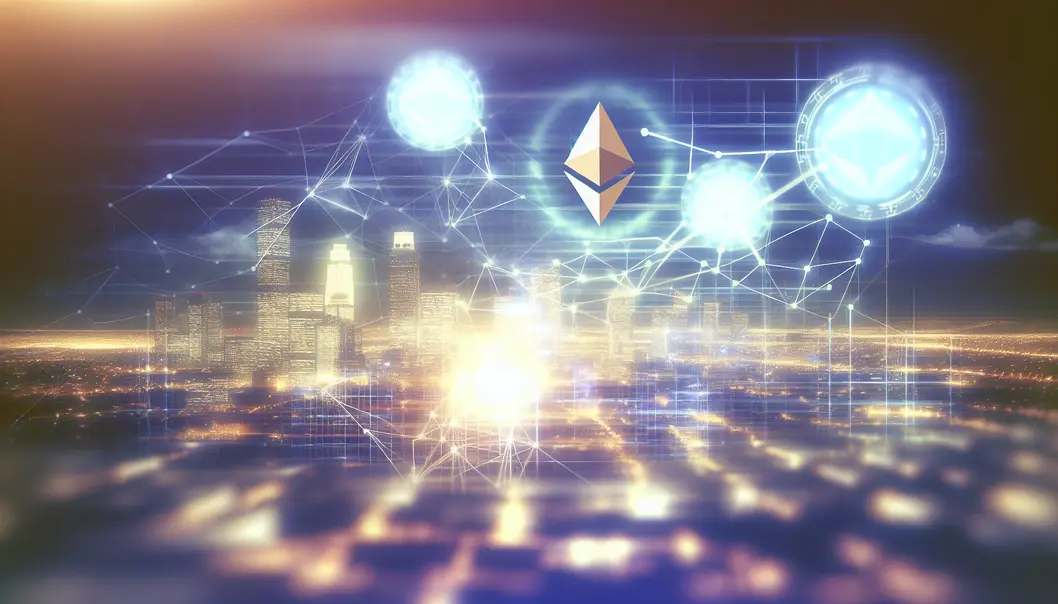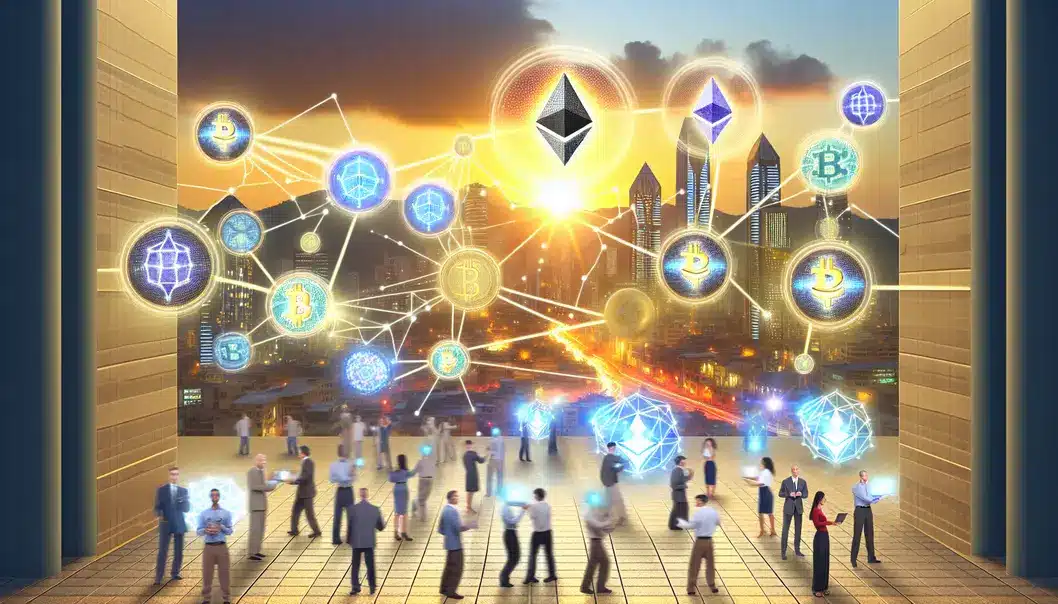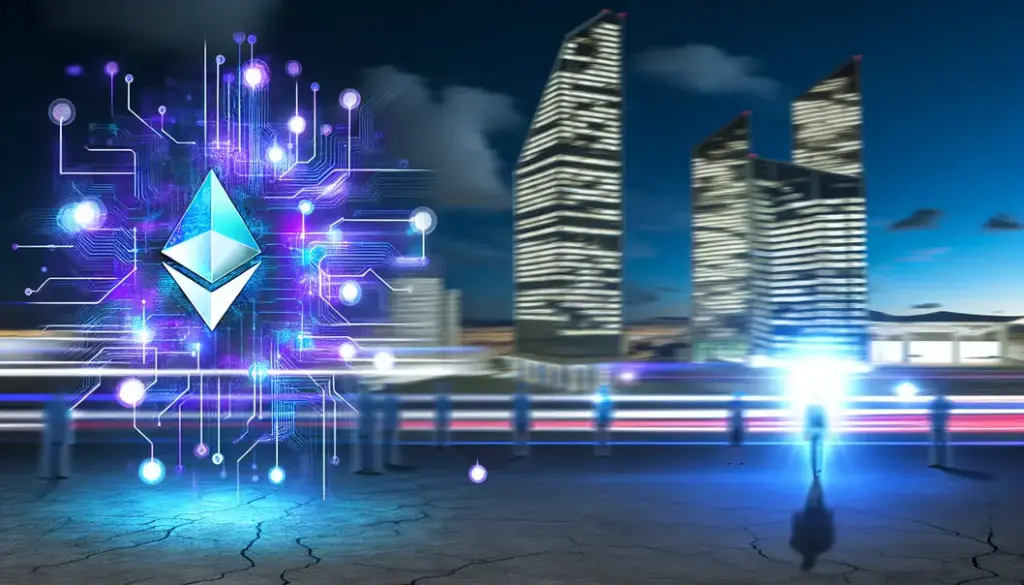As Ethereum celebrates its 10th anniversary, it’s like a tech-behemoth sprinting through a blockchain jungle of challenges and triumphs! Prepare yourself for a wild ride as we explore Ethereum’s cutting-edge advancements, its battles against fierce rivals, and its charm offensive in the world of business and regulation. Every chapter illuminates a facet of Ethereum’s journey in 2025, so buckle up and get ready to dive deep into the crypto-cosmos!
Forging Ahead: Technological Breakthroughs in the Ethereum Ecosystem by 2025

Ethereum stands at the forefront of rapid technological evolution, as 2025 witnesses a transformative phase for the blockchain giant. The shift from Proof of Work (PoW) to Proof of Stake (PoS) marked a pivotal turn, dramatically slashing energy consumption and propelling Ethereum into a new era of efficiency. This transition, known as The Merge, has not only bolstered transaction speeds but also enhanced network security, showcasing Ethereum’s commitment to sustainability and decentralization.
Sharding is another beacon of innovation within Ethereum’s roadmap. By fragmenting the blockchain into smaller, parallel chains, this technique alleviates congestion and significantly boosts processing capacity, allowing multiple transactions to occur simultaneously. Complementing sharding are the pivotal Layer 2 solutions that work tirelessly to reduce gas fees. These off-chain mechanisms spearhead reduced latency and improved user experiences, crucial in maintaining Ethereum’s competitive edge amidst growing alternatives.
In March 2025, the Pectra upgrade heralds a new chapter for Ethereum. This landmark upgrade, integrating the Prague and Electra updates, introduces dynamic features like account abstraction, which simplifies user interactions and supports diverse transaction types. The smart contract optimizations emerging from this upgrade promise reductions in gas fees and heightened transaction throughput, while enhanced staking mechanisms bolster validator participation with increased staking limits and flexible withdrawal options.
A significant highlight on the horizon is the integration of the hardware-accelerated zkEVM. This advancement is set to redefine scalability and privacy on the Ethereum mainnet, following its rigorous testing on the Telos testnet. With zkEVM, Ethereum seeks to marry the principles of scalability and privacy seamlessly, making transactions more efficient and secure.
The technological advancements in Ethereum are also closely intertwined with regulatory frameworks, a crucial aspect for institutional trust and adoption. By navigating regulatory landscapes adeptly, Ethereum not only ensures compliance but fortifies its position as a reliable blockchain for enterprises and individuals alike. This adaptability is essential amidst rising competition from platforms eager to capture segments of the decentralized finance market. To explore how these technological upgrades align with investment strategies, you can refer to this comprehensive guide for Ethereum investors in 2025.
As Ethereum continues to innovate, the ecosystem remains fertile ground for decentralized finance (DeFi), non-fungible tokens (NFTs), and decentralized autonomous organizations (DAOs). The platform’s ability to adapt and lead amidst evolving technologies cements its role as a formidable leader poised to shape the future of blockchain technology in the coming years.
Ethereum Ecosystem 2025: Battling Rivals and Overcoming Hurdles

In the rapidly evolving blockchain landscape, Ethereum in 2025 finds itself at a critical juncture, balancing between formidable competition and internal challenges. This reflection is essential as we navigate through a complex web of technological, economic, and regulatory threads that define Ethereum’s journey. With its 10th anniversary, Ethereum has managed to position itself as both a pioneer and a contender in the blockchain arena.
The transition to Ethereum 2.0 and The Merge marked a significant leap towards sustainability and efficiency, reducing the network’s energy consumption drastically. This environmental milestone strongly aligns with global trends toward sustainable technology, but it’s not devoid of challenges. Competing platforms like Solana and Binance Smart Chain boast faster transaction speeds and lower costs, threatening Ethereum’s dominance. Yet, Ethereum’s strategic embrace of Layer 2 solutions like rollups and state channels demonstrate its commitment to addressing scalability.
Rollups consolidate numerous transactions, thereby alleviating network congestion and reducing fees. This approach, alongside the innovative sharding technology, aims to bolster transaction throughput—a critical aspect as Ethereum continues to contend with high demand during peak times. In regions where speed and cost are paramount, these advancements are vital for Ethereum’s resilience and competitiveness.
However, the regulatory environment presents another set of complexities. Clear guidelines are imperative for fostering trust in Ethereum’s DeFi and NFT sectors. Although some fear that overregulation could stifle innovation, others anticipate that it will potentially open doors to larger institutional investments. Such investments could assure significant capital inflows, allowing Ethereum to fund further technological advancements and solidify its market position.
Moreover, the vast Ethereum developer community is a powerful engine for innovation. It facilitates dynamic adaptation to market needs, providing a fertile ground for developing solutions that ensure Ethereum remains indispensable. Interoperability with other blockchains will further broaden Ethereum’s reach, making asset transfers seamless and enhancing its utility across different platforms. This expands Ethereum’s ecosystem, strengthening its leadership in a competitive landscape.
For a more in-depth look at Ethereum’s evolving scene, explore further insights. As Ethereum’s ecosystem continues to mature, success hinges on its ability to navigate these challenges while capitalizing on opportunities for growth and technological refinement. The journey through 2025 will thus be a test of adaptability and tenacity in a dynamic and rivalrous blockchain world.
The Backbone of Trust: Enterprise and Regulatory Synergy in Ethereum’s 2025 Landscape

In 2025, Ethereum stands at the forefront of enterprise adoption, fueled by strategic institutional investments and evolving regulatory frameworks. Major financial players like BlackRock and UBS have become increasingly involved with Ethereum, leveraging its capabilities to tokenize traditional assets. This transformation not only facilitates greater liquidity but also symbolizes a pivotal shift towards blockchain-based financial ecosystems. Companies such as State Street are at the helm of this tokenization movement, partnering with technology innovators like Taurus. By converting real-world assets into blockchain tokens, these enterprises are pioneering a new era of stability and demand for Ethereum, solidifying its central role in the digital economy.
Ethereum’s prowess in decentralized finance (DeFi) and smart contracts continues to be a magnet for enterprise engagement. This robust ecosystem supports diverse institutional functions, such as borrowing and lending, further enhancing Ethereum’s utility and cementing its position as the go-to platform for decentralized financial solutions. The burgeoning interest in DeFi protocols underscores Ethereum’s potential to redefine traditional financial operations, offering efficient and transparent alternatives.
Regulatory clarity is pivotal in shaping Ethereum’s enterprise adoption landscape. By 2025, significant progress has been made in establishing coherent global guidelines, which have alleviated previous uncertainties for institutional investors. The EU’s Markets in Crypto-Assets (MiCA) framework represents one of the landmark regulatory advancements, offering a structured approach to compliance, albeit with some challenges for smaller entities due to increased costs. This regulation endows the market with legal stability and assurance, fostering confidence among larger enterprises.
Across the Atlantic, the U.S. regulatory environment is transitioning to a more welcoming stance towards cryptocurrencies, potentially limiting the SEC’s once extensive powers. This shift makes the United States a more attractive environment for crypto-related businesses, bolstering Ethereum’s enterprise engagements. Notably, the SEC’s approval of Ethereum-based ETFs in 2024 marked a significant milestone, enhancing investment accessibility and reinforcing investor trust.
The synergy between regulatory evolution and enterprise adoption forms the backbone of Ethereum’s strategic growth. Clear regulatory frameworks provide the necessary confidence for enterprises to explore and implement Ethereum-centric solutions, fostering an ecosystem conducive to innovation and expansion. While compliance costs may deter smaller firms, larger corporations with robust compliance infrastructures are poised to thrive in this regulatory landscape.
Looking forward, technological advancements within Ethereum, including upgrades like Ethereum 2.0, are expected to bolster its scalability and usability, making the platform ever more attractive for enterprise applications. As Ethereum 2025 ecosystem continues to mature, its integration into the enterprise sphere is likely to deepen, driven by a confluence of institutional investment and progressive regulatory policies.
Final thoughts
Ethereum’s 2025 saga unfurls as a narrative of innovation and resilience. From tech breakthroughs to competitive skirmishes and regulatory dance-offs, Ethereum’s ability to juggle advancements with enterprise poise marks its enduring presence. Hold tight as this blockchain behemoth continues to reshape digital finance landscapes, proving its mettle time and again.
Ready to elevate your business with cutting-edge automation? Contact Minh Duc TV today and let our expert team guide you to streamlined success with n8n and AI-driven solutions!
Learn more: https://ducnguyen.cc/contact/
About us
Minh Duc TV is a forward-thinking consulting firm specializing in n8n workflow automation and AI-driven solutions. Our team of experts is dedicated to empowering businesses by streamlining processes, reducing operational inefficiencies, and accelerating digital transformation. By leveraging the flexibility of the open-source n8n platform alongside advanced AI technologies, we deliver tailored strategies that drive innovation and unlock new growth opportunities. Whether you’re looking to automate routine tasks or integrate complex systems, Minh Duc TV provides the expert guidance you need to stay ahead in today’s rapidly evolving digital landscape.



